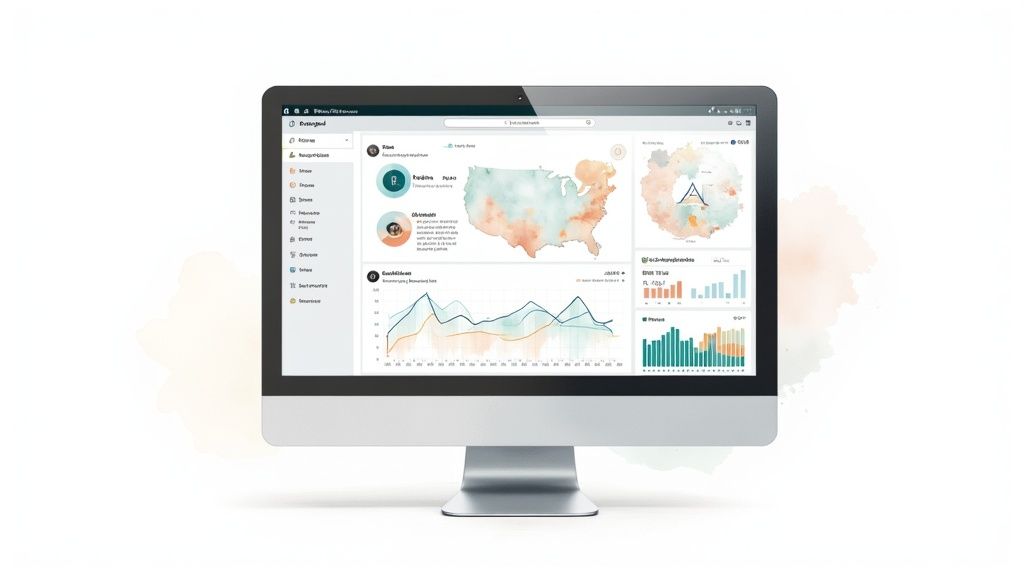




Follower counts are often seen as superficial metrics. However, tracking Twitter followers provides valuable data for analyzing the effectiveness of your social media strategy. The goal isn't simply accumulating large numbers, but rather understanding audience engagement with your content. Monitoring follower growth and decline offers a clearer perspective on content effectiveness.
Tracking followers allows you to connect content performance directly to audience growth. A sudden increase in followers after a specific tweet, for instance, suggests that the content resonated well. Conversely, stagnant or decreasing follower numbers may signal that adjustments are needed. This real-time feedback loop is invaluable for refining your content strategy. Follower tracking is also critical for evaluating the impact of specific campaigns. Analyzing follower growth during a campaign provides data for assessing its success and identifying areas for future improvement.
Shifts in follower demographics can reveal changes in your target market. For example, variations in follower location, interests, or language usage can indicate emerging trends. This knowledge is essential for adapting your strategy to connect with new audience segments or refine your messaging to better resonate with an evolving audience. Recognizing these shifts allows you to maintain a relevant and up-to-date presence on Twitter.
Tracking Twitter followers over time is essential for understanding the long-term impact of social media strategies. The HISTORY Twitter account, for example, presents a compelling case study. Recent data shows HISTORY with approximately 2.78 million followers. Significantly, their follower count exhibits a consistent growth rate, estimated at about 489 followers per day. This steady growth underscores the power of engaging content. HISTORY Twitter Account Analysis offers a detailed breakdown of their statistics.
This data-driven approach empowers businesses to improve engagement and achieve sustainable growth. Analyzing trends enables businesses to refine their marketing strategies for better targeting and follower retention. Some brands have successfully used follower insights to determine optimal posting times, tailor content to specific audience segments, and even anticipate future trends. This proactive approach transforms follower data into actionable insights, ultimately leading to more informed decisions and optimized Twitter strategies for maximum impact.

Going beyond a simple follower count, using analytics tools can significantly improve your understanding of your Twitter audience. These tools offer valuable data on follower growth, demographics, and engagement trends. This section analyzes various options for effective Twitter follower tracking.
The built-in Twitter Analytics dashboard provides a good starting point for tracking follower growth. This tool delivers basic metrics like impressions, engagement rate, and follower counts. You can also compare two metrics side-by-side and analyze data ranging from the past week to a full year. However, the native platform has limitations. Exporting data for more in-depth analysis, for example, can be difficult.
Third-party tools offer more advanced Twitter follower tracking features. These platforms often provide comprehensive dashboards, historical data analysis, and competitor analysis capabilities. This gives you a much more granular view of your follower growth and lets you benchmark against competitors. Several tools specialize in tracking historical Twitter data. This is especially valuable since Twitter itself doesn't readily provide access to historical follower counts. Tools like Tweet Binder and Klipfolio's PowerMetrics solve this problem by enabling users to track and analyze follower growth over time. PowerMetrics, for instance, can collect data on followers, following, mentions, likes, and retweets, giving you insights into historical trends. Learn more about historical Twitter data analysis. These tools allow you to identify successful strategies, assess campaign impact, and analyze competitor performance.
The best tracking tool for you depends on your specific needs and budget. Popular choices include SproutSocial, Brand24, and Hootsuite. These platforms offer varying levels of functionality, from basic follower tracking to advanced analytics and reporting. Some offer free versions with limited features, while others have premium subscriptions for more comprehensive data and analysis.
To simplify your decision, the following table compares the key features of several leading platforms. This table aims to provide a clear overview of the available options and highlight the differences in their capabilities and pricing.
Twitter Follower Tracking Tools Comparison: This table compares the key features, pricing, and capabilities of the most popular Twitter analytics tools to help you choose the right one for your needs.
| Tool Name | Free Option | Historical Data | Competitor Analysis | Export Features | Price Range |
|---|---|---|---|---|---|
| SproutSocial | Limited | Yes | Yes | Yes | $99 - $249+ /month |
| Brand24 | Trial | Yes | Yes | Yes | $49 - $199+ /month |
| Hootsuite | Limited | Yes | Limited | Yes | $99 - $739+ /month |
| Twitter Analytics | Yes | Limited | No | Limited | Free |
| Tweet Binder | Trial | Yes | Yes | Yes | $99 - $ Custom /month |
This comparison showcases the variety of features offered. While Twitter Analytics offers basic tracking for free, premium tools like SproutSocial and Brand24 provide more robust historical data, competitor analysis, and export options. Select the tool that best aligns with your budget and analytical needs. For a deeper understanding of follower behavior, consider employing tools for robust social media analytics. Focus on tools that allow for effective follower tracking and deliver actionable insights.

Not all follower metrics offer the same value. Some are merely vanity metrics, while others provide crucial insights into audience health and growth. Effective Twitter follower tracking requires distinguishing between these metric types to make data-driven decisions and refine your Twitter strategy.
Vanity metrics, like raw follower count, can be deceptive. A large following doesn't automatically equate to high engagement. Instead, focus on actionable metrics that reveal audience behavior.
These include:
For deeper analysis, consider using robust social media analytics tools to understand the nuances behind the numbers.
Growth velocity tracks the rate of follower increase or decrease, offering a more dynamic perspective than static follower counts. Engagement quality delves deeper than likes and retweets, examining the depth of interaction. Are followers actively discussing and sharing your content? These qualitative aspects are critical.
Follower retention rate indicates how effectively you maintain existing follower engagement. High retention suggests resonant content and fosters loyalty. Influence score assesses your Twitter impact, measuring how often users engage with and share your posts. This reflects your reach and authority within your niche.
Performance analysis requires context. Industry-specific benchmarks provide valuable comparisons, allowing you to evaluate your metrics against competitors and pinpoint areas for improvement. Twitter's global reach, with over 368 million monthly active users as of December 2022 (now X), presents both opportunities and challenges. Find more detailed statistics here.
Calculating monthly growth rate, for instance, offers valuable insights into strategy effectiveness. A profile with 5,293 followers on March 1st and 5,428 on March 31st has a growth rate of approximately 2.55%. Analyzing such metrics helps benchmark performance and gauge the success of tactics like promoted tweets or Twitter chats, particularly in competitive global markets.
Accurate follower data interpretation is paramount. Data misinterpretations can lead to ineffective strategies. For example, mistaking a temporary follower surge for sustained growth creates unrealistic expectations.
Beware of artificial growth tactics that inflate follower numbers without genuine engagement. These tactics undermine long-term audience building. Instead, prioritize cultivating an authentic, engaged audience for sustainable growth and a robust Twitter presence.

Premium social media tracking tools aren't always necessary for actionable insights. Resourceful social media managers often build custom tracking systems that provide significant value without the hefty price tag. This involves using simple but effective tools like spreadsheets and a strategic approach to data collection. To truly understand follower growth, it's crucial to analyze engagement alongside raw numbers. For a more in-depth look at performance measurement, consider resources on social media engagement metrics.
Spreadsheets, specifically Google Sheets or Microsoft Excel, offer remarkable flexibility for tracking Twitter followers. Customizable templates can automatically calculate important metrics and visualize growth trends. Begin by logging your daily follower count. Then, add columns to calculate metrics like daily change, weekly change, and the overall monthly growth rate.
Basic formulas, such as =(Current Day Followers - Previous Day Followers), easily calculate daily changes. These daily changes can then be summed for weekly and monthly totals. Visualizing this data with built-in charting tools provides clear insights. Line graphs, for example, effectively illustrate follower growth over time, offering a readily understandable view of your progress.
Consistency is paramount for accurate data analysis. Set regular intervals, such as daily or weekly, for recording follower counts. This consistent data collection provides a much more accurate picture of trends and patterns than sporadic checks. Tracking your followers at the same time each day, for instance, helps account for natural daily fluctuations and establishes a stable baseline.
However, weekly checks might suffice depending on your specific goals and the frequency of your Twitter activity. The key is to maintain a regular schedule, ensuring that your data remains reliable and comparable.
DIY tracking systems allow you to connect content publication with follower fluctuations. When you post different content types, monitor the corresponding changes in follower numbers. This reveals which content truly resonates with your target audience and fuels follower growth.
Furthermore, documenting engagement metrics–likes, retweets, and replies–alongside follower counts offers even deeper analysis. This reveals whether new content is attracting new followers or simply engaging existing ones. This distinction is critical for understanding the true impact of your content strategy.
Disciplined data collection is the cornerstone of an effective DIY system. Use calendar reminders or task management applications like Trello or Asana to ensure regular tracking. This avoids missed data points and maintains the overall integrity of your data.
Creating downloadable templates also streamlines the process. These templates should incorporate the formulas and charts mentioned earlier, saving time and simplifying analysis. This efficiency allows you to focus more on interpreting the data, rather than manual calculations. Perhaps most importantly, these DIY approaches often uncover unique insights that automated systems miss, while simultaneously developing your intuitive understanding of your audience.
Tracking your Twitter followers is fundamental. But to truly understand your audience and make strategic decisions, you need to delve deeper. This section explores advanced analytical methods that offer a more granular perspective on follower behavior and can significantly enhance your Twitter strategy.
Segmentation divides your followers into distinct groups based on shared characteristics. These characteristics might include demographics, interests, or online behavior. Rather than treating your audience as a single entity, segmentation allows you to tailor content to specific groups. For instance, a business could segment followers by engagement level (highly active, moderately active, inactive). This targeted approach allows for specific messaging to re-engage inactive followers while delivering tailored content to those highly active users.
Cohort analysis focuses on groups of followers acquired within a specific timeframe – a cohort. This method helps identify which acquisition strategies yield the most valuable followers over the long term. For example, followers acquired through a targeted marketing campaign might demonstrate higher long-term engagement than those gained organically. This data is crucial for optimizing future campaigns and allocating resources effectively.
Predictive modeling uses statistical techniques and historical data to forecast future follower growth. By analyzing past growth trends correlated with specific content or posting schedules, businesses can project future growth and pinpoint areas for improvement. This approach can reveal potential growth opportunities and inform strategic planning. You might find resources like How to master crypto market analysis tools useful for understanding predictive modeling techniques.
Analyzing competitor activity on Twitter offers valuable insights. Examining their follower growth and engagement can reveal industry benchmarks and uncover potential content opportunities. Understanding what resonates with their audience allows businesses to adapt successful tactics and differentiate their own approach. This could involve studying their content strategy, hashtag usage, or even the types of media they share.
Controlled testing involves isolating specific variables to determine their real impact on follower growth. This establishes causation, a stronger relationship than mere correlation. For example, testing different headline formats while keeping all other content elements constant helps determine which style drives greater follower engagement.
These advanced techniques require more time and resources, but the strategic advantages are significant. They provide a more nuanced understanding of audience behavior, leading to more effective content and improved campaign performance. This deeper understanding can transform your Twitter presence, enabling you to build a more engaged and loyal following. You move beyond simply tracking follower counts to developing a data-driven strategy that maximizes your impact.
The following table details various Twitter growth strategies and the corresponding metrics and tracking methods to measure their effectiveness.
| Growth Strategy | Key Metrics to Track | Tracking Frequency | Expected Impact | Best Tracking Tools |
|---|---|---|---|---|
| Content Marketing | Engagement (likes, retweets, comments), Reach | Daily/Weekly | Increased brand awareness, organic follower growth | Twitter Analytics, SproutSocial |
| Hashtag Campaigns | Hashtag usage, Reach, Impressions | Daily/Weekly | Increased visibility, targeted follower growth | Brand24, Tweet Binder |
| Influencer Collaboration | Mentions, Retweets, New Followers | Weekly/Monthly | Expanded reach, credibility boost | SproutSocial, Brand24 |
| Paid Advertising | Click-Through Rate, Conversions, New Followers | Daily/Weekly | Rapid follower growth, targeted audience reach | Twitter Ads Manager |
| Community Engagement | Replies, Mentions, Direct Messages | Daily/Weekly | Increased brand loyalty, improved engagement | Twitter Analytics, Hootsuite |
Utilizing these techniques allows you to use data for strategic advantage, turning your Twitter presence from a passive platform into an active engine for growth and engagement.
Tracking Twitter followers isn't simply about watching the numbers grow; it's about leveraging that data to inform strategic decisions. Much like a ship's captain uses navigational tools, follower data guides your Twitter strategy toward success. This analysis explores how social media directors use data to achieve measurable growth on Twitter.
Effective Twitter strategies are dynamic and constantly evolving. Analyzing follower data creates a continuous feedback loop, informing content creation and refining your approach over time. For instance, if tweets incorporating video content consistently correlate with higher follower growth, future content planning should prioritize video production. This iterative process of analyzing, adjusting, and refining is crucial for sustained growth.
Follower data provides valuable insights into causal relationships between specific content elements and audience behavior. Does the use of certain hashtags correlate with an increase in followers? Do particular tweet formats (e.g., images, polls) generate more engagement? By isolating these variables, you can determine which content elements resonate with your target audience and drive growth. This data-driven approach moves beyond simple correlation to identify causation, enabling strategic adjustments to content style, timing, and format.
Data isn't just for internal analysis; it's crucial for demonstrating value to stakeholders. Transform complex metrics into clear, concise presentations using visualizations like charts and graphs to effectively communicate the impact of your Twitter strategy. Quantifiable results, such as increased follower growth and improved engagement rates, demonstrate a clear return on investment (ROI), securing buy-in for future initiatives and justifying resource allocation.
Follower data empowers strategic prioritization. Decision-making models based on follower growth and engagement patterns can guide your efforts. Setting achievable growth targets, informed by historical data and industry benchmarks, creates realistic goals and sets the stage for success. These targets should be rooted in a data-driven understanding of your Twitter performance and audience behavior, not arbitrary numbers.
A data-informed content calendar is a roadmap for sustained growth. By analyzing peak engagement times and follower response to various content types, you can strategically schedule posts for maximum impact. This proactive approach ensures your content reaches the intended audience at the optimal time, driving consistent engagement and fueling follower growth.
Ready to transform your Twitter strategy with powerful data insights and community-driven intelligence? Explore Coindive today and unlock the full potential of your crypto community. Discover Coindive now!